Irises have captivated flower lovers for centuries with their tropical style and striking beauty. Successfully growing these stunning flowers includes understanding when irises bloom. With over 300 iris species in existence, it’s also important to understand that different plant varieties may bloom at different times.
The most common type of iris is the bearded iris, which starts blooming in early to mid-spring. However, there are other factors in play (like different climates and cultivars) that can influence when this and other types of irises show off their showy petals.
Discover the iris peak season by Zone plus factors that influence bloom timing below. And stick around for tips on how to prolong iris blooms while on the plant or as cut flowers.
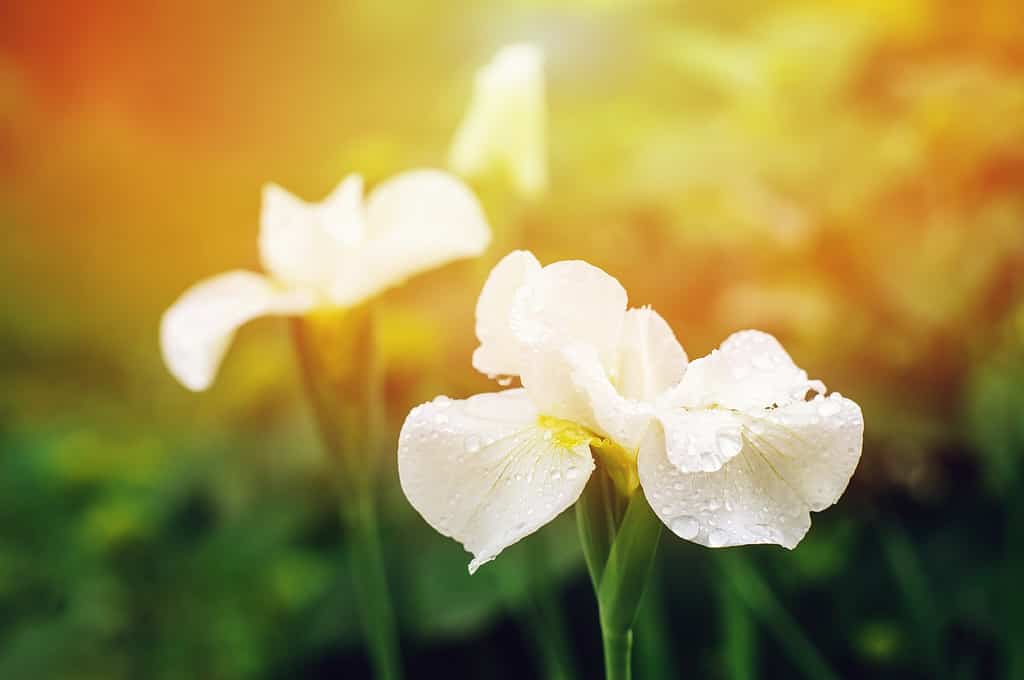
Most irises bloom in spring and summer in Zones 4–9.
©Mkovalevskaya/iStock via Getty Images
Types of Irises and Their Bloom Timing
Irises usually produce upright flowers with three standing petals and three drooping petals. However, there can be differences in iris flower style, as well as different bloom timings per plant variety.
Knowing the variations in bloom timing between iris types could help gardeners create a continuous display of these flowers throughout the growing season.
So, before we look at iris peak season by Zone, note below some common types of irises and their general bloom timing.
Bearded Irises (Iris germanica)
Bearded irises have large blooms with lower petals that make them look as if they have beards. Their showy flowers feature large upright and cascading petals on top of long green stalks.
- The bearded iris blooms from early spring through early summer. However, there are also reblooming bearded iris cultivars that produce flowers again in late summer or early fall.
- Also called German irises, bearded irises are hardy in USDA Hardiness Zones 3–9.
Siberian Irises (Iris sibirica)
Very showy Siberian irises don’t have the beard-shaped petals of bearded irises. However, Siberian irises still offer large blooms with vibrant tropical flower style.
- Siberian irises bloom in the early to mid-summer months.
- Like bearded irises, Siberian irises are hardy in Zones 3–9.
Japanese Irises (Iris ensata)
Water-loving Japanese irises produce flat, beardless, and velvety blooms. Japanese irises thrive in moist soil as long as it is well-draining.
- You can expect gorgeous Japanese irises to bloom in early summer.
- As they are slightly less cold-hardy than other varieties, Japanese irises grow best in Zones 4–9.
Louisiana Irises (Iris louisiana)
Like Japanese irises, Louisiana irises love warm climates and produce beardless blooms. Their flowers are fan-shaped, and the plants perform best with consistent deadheading (removing the spent blooms).
- Louisiana irises bloom in early to mid-summer.
- The best Zones for growing Louisiana irises are 4–10.
Dutch Irises (Iris hollandica)
As with most irises, Dutch iris flowers also have three upright and three cascading petals. This colorful hybrid species is popular as a florist flower, though it has no fragrance. It is also adaptable to different types of soil in the garden.
- Dutch irises bloom in late spring and early summer.
- The Dutch iris plant is hardy in Zones 5–9.
Dwarf Irises (Iris reticulata)
If you love irises but prefer petite flowers, the dwarf iris is a great option. While bearded irises can grow at least 3 feet tall, dwarf irises typically don’t get taller than 5-8 inches high. The flower shape of dwarf irises is also slightly different, with three upright petals mingling between three spreading petals. They also bloom earlier than other Iris varieties!
- Dwarf irises bloom in late winter to early spring.
- The best USDA Hardiness Zones for dwarf irises are 4–9.
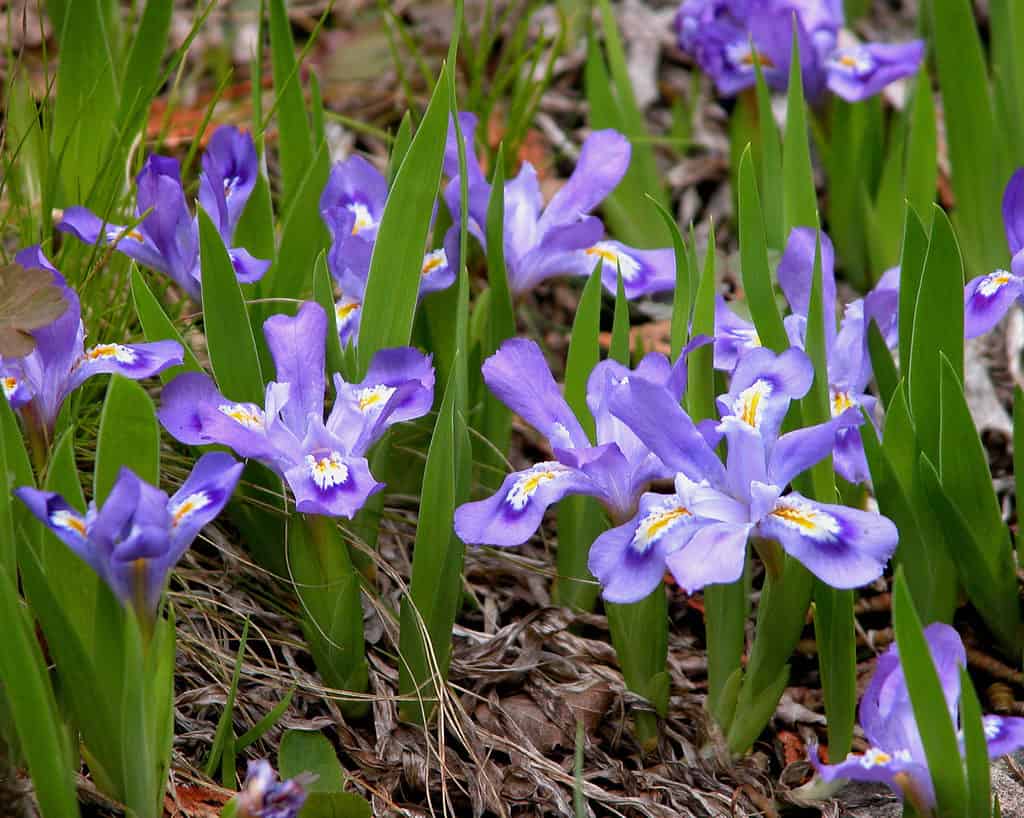
Dwarf irises can bloom in late winter in Zones 4–9, which is earlier than other types of iris plants.
©Joel Trick, USFWS, Public domain, via Wikimedia Commons – License
Peak Iris Season by Zone
Learning the peak iris season in your local climate is much easier when using the USDA Hardiness Zone map. By dividing the U.S. into Zones based on the lowest average temperature, this map helps gardeners know which plants will survive through winter.
Here’s a quick breakdown of peak iris season by Zone:
Zones 3-4
Bloom Timing: Because of the cooler average temperatures, irises usually bloom in Zones 3–4 in late spring to early summer
Ideal Iris varieties for these Zones: Most irises will bloom in Zone 4, but bearded and Siberian irises are best for Zone 3.
Zones 5-6
Bloom Timing: Depending on the variety, irises in Zones 5–6 bloom in early spring to early summer. However, dwarf irises can bloom as early as late winter.
Ideal Iris varieties for these Zones: These Zones have the perfect climate for most iris plants.
Zones 7-8
Bloom Timing: Most irises in Zones 7-8 bloom between early spring and summer.
Ideal Iris varieties for these Zones: These warmer Zones still have ideal temperatures to sustain most iris plants.
Zones 9-10
Bloom timing: Depending on the variety, irises bloom between early spring and early summer in Zones 9–10. However, the climate in Zone 10 might not be suitable for more varieties than Louisiana iris plants.
Ideal Iris varieties for these Zones: Louisiana irises are suitable for Zones 9–10.

Bearded irises bloom in early spring to early summer in Zones 3–9, and reblooming varieties bloom again in late summer.
©yuelan/iStock via Getty Images
The Ideal Conditions for Blooming Irises
Providing your irises with ideal conditions will keep them blooming each spring and summer for many years. So, ensure that a plant’s basic needs (listed below) are met first, then enjoy the incredible floral display.
Ideal Climate
- The ideal climate for irises is a temperate one with average annual temperatures between 45° and 95 °F.
- Irises need both cold winters and warm summers to thrive as perennial plants.
- Some Iris varieties, like the Louisiana iris, enjoy the warmer temperatures of Zones as high as 10.
Optimal Sunlight
- Irises need full sunlight for 6–8 hours per day. This amount of sun exposure is necessary for the plants to bloom.
- If growing in high-heat climates, irises may need a source of shade during the hottest hours of the day. Otherwise, the flowers might scorch and dry up.
Best Iris Soil Types
- Soil containing loam, chalk, sand, or clay works well for growing irises.
- Some Iris varieties, like Japanese iris, prefer wetter soil than others. However, a good rule of thumb is to provide moist, well-draining soil that doesn’t get soggy. Waterlogged roots are susceptible to rot.
- Irises need slightly acidic soil with a pH between 6.0 and 7.0. Test your soil before planting irises and amend it if necessary. Adding lime can make the soil less acidic. Adding sulfur can make the soil less alkaline.
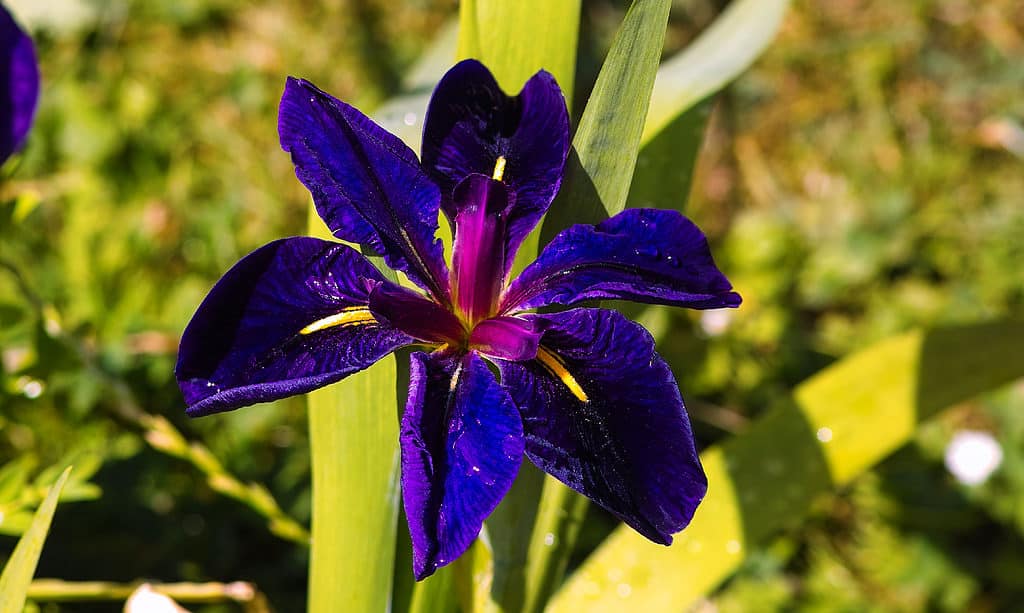
Louisiana irises bloom in early to midsummer in Zones 4–10.
©Ole Schoener/Shutterstock.com
How to Prolong Iris Blooms on the Plant
If your plants are healthy, iris blooms can last up to two weeks. We recommend the following practices to help iris flowers last as long as possible:
Deadheading
Remove spent iris blooms to encourage the plant to produce more buds. To do so, cut the stem just above the first set of leaves you see on the stem.
Proper Fertilizing
Encouraging long-lasting iris blooms by using fertilizer only works if you use the right product at the right time. Try a balanced fertilizer like 10-10-10 and apply it in early spring. If you feel your plants need it, add another fertilizer application after the flowers have died.
Proper Watering
Most Iris varieties grow well in well-draining soil that is kept moist. However, it’s surprising that these water-loving plants are easy to overwater in your garden.
Established irises benefit from occasional deep watering at the soil level, not directly above the plants. Otherwise, the rule of thumb is to let the top 1-2 inches of soil dry out before watering the irises again.
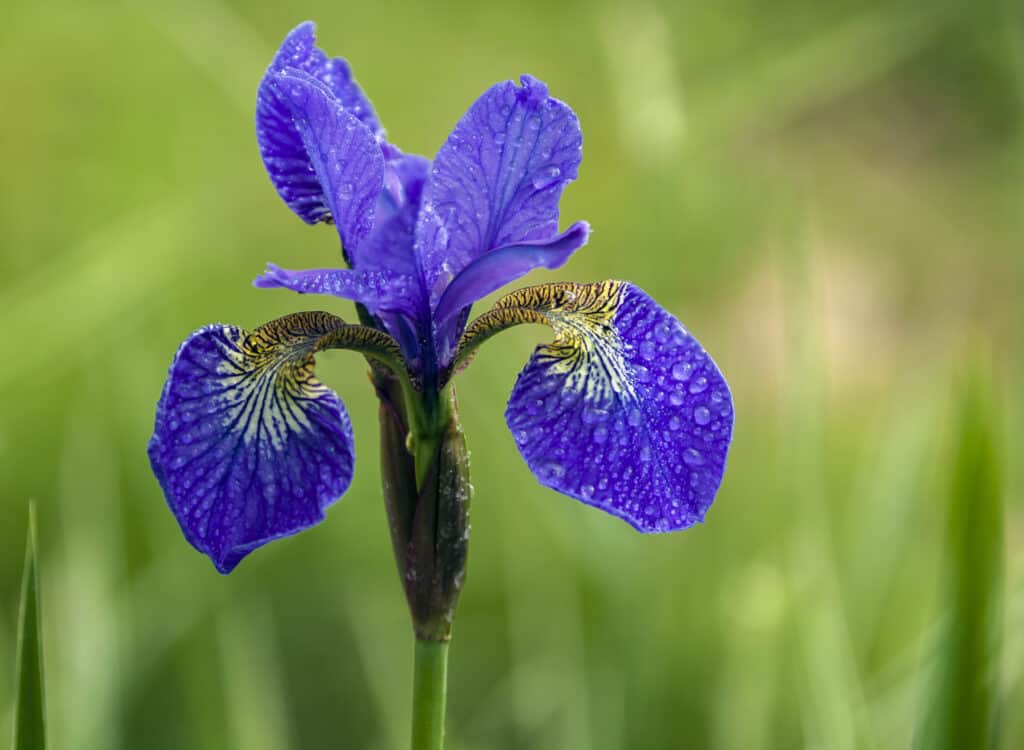
Siberian irises bloom in early to mid-summer in Zones 3–9.
©iStock.com/Svetlana Popova
How to Prolong Your Cut Iris Blooms
Irises usually last 3–5 days as cut flowers. To extend the life of your cut iris blooms for as long as possible, follow these simple steps:
Clean and Sharpen Your Tools First
Dull scissors and unclean shears can damage iris stems, causing the blooms to die early. So clean and sharpen your flower tools before harvesting flowers to avoid causing water blockage in the cut stems.
Harvest Irises Before They Open
The best time to cut irises for arrangements is when you can see some petal color but the blooms aren’t yet open. Cutting the flowers this early will allow them to open in the vase and last longer.
Add A Flower Preservative
Iris blooms last longer as cut flowers when you set them in water with flower preservatives. A quality flower preservative is available for purchase wherever flower supplies are sold. You can also make your own preservative by adding 2 tablespoons of sugar and 2 tablespoons of lemon juice to 1 quart of water.
Keep the Vase Water Fresh
Replace your vase water every couple of days to keep it fresh. Your cut irises will last longer if they aren’t battling the bacteria growth from “old” water.
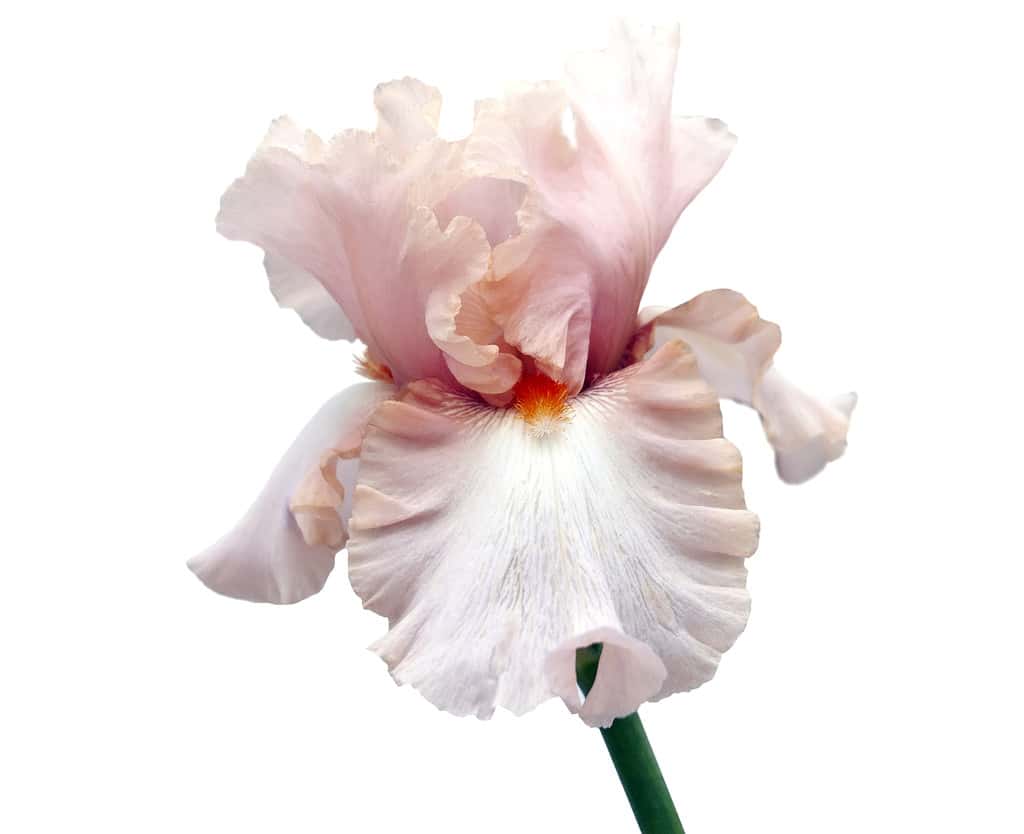
Cut iris blooms last longer if harvested before they are fully open.
©TatianaMironenko/iStock via Getty Images
Why Your Irises Might Not Bloom
From pest infestations to overcrowded bulbs, there are several reasons iris plants might not produce flowers.
We already discussed that irises need plenty of sunlight, moderate to warm temperatures, and moist soil with the proper pH. So, if you’ve already checked those factors, here are additional conditions to watch for if your irises don’t boom:
Iris Pests
According to the University of Minnesota Extension, iris borer caterpillars are common pests that feed on iris leaves and bulbs. The damage these pests cause can prevent irises from blooming and make the foliage turn brown.
Solution: To prevent damage from iris borer caterpillars, you can apply pesticides in the spring when the eggs are hatching. Or you can introduce roundworms to your garden, where irises grow. Roundworm species like Heterorhabditis and Steinernema love to attack iris borer caterpillars. However, roundworms aren’t always a reliable source of pest control, and they require special conditions to thrive, like a moist environment.
Not Enough Fertilizer
Irises are easy to maintain, so not all plants need fertilizer support. However, a non-blooming plant indicates it might need more or a better balance of nutrients.
Solution: Test your soil first for its pH and nutrient content. Then, if needed, amend the soil with a balanced fertilizer early in the spring, such as a 10-10-10 mix. Fertilize again in the summer after any blooms your plants produce die off.
On the other hand, too much fertilizer can also create non-blooming iris plants. If you notice that your iris plants are foliate-heavy with no blooms, they might be getting too much fertilizer.
Overcrowded Rhizomes
Over time, iris bulbs (rhizomes) underground can crowd each other and hinder the plant’s ability to bloom. This condition is common among mature irises that have been growing from the same spot for several years.
Solution: Dig up your iris rhizomes in late summer or early fall. Divide the rhizomes and replant them about 12–24 inches apart. This practice gives the bulbs better air circulation and promotes new blooms on each plant.

Dutch irises bloom in late spring to early summer in Zones 5–9.
©ouchi_iro/iStock via Getty Images
It’s a captivating sight when irises bloom.
There’s nothing quite like the sight of a large garden bed or hillside full of iris blooms! It’s hard to look away from such a captivating view, and who would want to? So, keep your irises blooming to their full potential every year by giving them excellent care. Provide them with plenty of sunshine, the right amount of water, and the ideal climate to get your plants off to a strong start.
The photo featured at the top of this post is © Mark Byer/Shutterstock.com
Thank you for reading! Have some feedback for us? Contact the AZ Animals editorial team.






